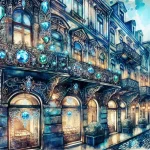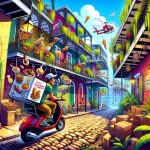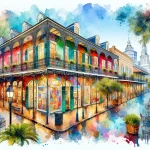Immerse yourself in the captivating arts scene within the heart of New Orleans’ French Quarter. This historic neighborhood, renowned for its unique cultural character, hosts an eclectic array of galleries showcasing exceptional works from local and international artists. From traditional fine art to contemporary and folk pieces, the French Quarter’s galleries offer a diverse and immersive experience that captures the distinctive spirit of New Orleans.
In This Article
TL;DR
- Galleries exhibit a wide spectrum of art styles, ranging from traditional Louisiana works to modern and abstract creations.
- These spaces preserve and reflect the rich cultural heritage of the French Quarter and its artistic evolution over time.
- Engaging activities like guided tours, special event nights, and understanding gallery etiquette enrich the visitor experience.
1. The Essence of French Quarter Art Galleries
The French Quarter art galleries are an integral part of New Orleans’ cultural identity, serving as a melting pot of historical and contemporary art. These spaces act as cultural hubs, attracting both locals and visitors who appreciate the unique blend of artistic styles on display. The galleries showcase works that pay homage to the city’s rich history while also embracing modern and innovative art forms, creating a dynamic and ever-evolving art scene.
2. A Closer Look at Notable Galleries
Rodrigue Studio
One of the most iconic galleries in the French Quarter is the Rodrigue Studio, known for showcasing the works of the late George Rodrigue, creator of the famous “Blue Dog” series. The studio features a wide range of Rodrigue’s paintings, sculptures, and prints, offering visitors a glimpse into the artist’s unique vision and his deep connection to Louisiana’s culture.
Address: 730 Royal Street, New Orleans, LA 70116
Hours: Open daily from 10 am to 6 pm
Phone: (504) 581-4244
Angela King Gallery
Another notable gallery is the Angela King Gallery, which specializes in contemporary art from both established and emerging artists. The gallery hosts regular exhibitions and artist talks, providing a platform for local and international talent to showcase their work.
Address: 241 Royal Street, New Orleans, LA 70130
Hours: Open Monday to Saturday from 10:30 am to 5:30 pm, Sunday from 12 pm to 5 pm
Phone: (504) 524-8211
3. Art Forms and Styles Represented
The French Quarter galleries offer a variety of art forms and styles, reflecting the rich cultural influences of Louisiana. Traditional Creole and Cajun art, characterized by vibrant colors and intricate designs, can be found alongside modern and abstract pieces that push the boundaries of artistic expression. Visitors can explore a wide range of mediums, including paintings, sculptures, photography, and mixed media works.
4. The Role of Galleries in Local Culture
The French Quarter art galleries play a vital role in the local community, serving as gathering places for art enthusiasts and cultural events. Many galleries participate in the First Saturday Gallery Openings, a monthly event where art lovers and collectors can explore the latest exhibitions and engage with artists and fellow art appreciators. These events often feature live music, food, and drinks, creating a festive atmosphere that celebrates the arts.
5. Historical Context and Evolution
The French Quarter’s art scene has evolved over time, with historic galleries like the Historic New Orleans Collection adapting to the changing cultural landscape. These galleries have maintained their relevance by showcasing both traditional and contemporary works, providing a bridge between the past and present. The evolution of the French Quarter’s art scene reflects the city’s resilience and ability to embrace change while preserving its rich cultural heritage.
6. Impact of Key Figures and Movements
The French Quarter galleries have been influenced by numerous key figures and movements in the art world. Local artists like James Michalopoulos and Terrance Osborne have made significant contributions to the scene, with their distinctive styles and commitment to capturing the essence of New Orleans. The galleries also showcase works from internationally renowned artists, exposing visitors to a wide range of artistic perspectives and movements.
7. Visitor Experience: Engaging with the Art
To fully immerse yourself in the French Quarter’s art scene, consider taking a guided tour of the galleries. Many galleries offer tours led by knowledgeable guides who provide insights into the artists and their works. Visitors can also attend special event nights, such as exhibition openings or artist talks, to engage directly with the art community.
When visiting the galleries, it’s essential to observe proper etiquette. Refrain from touching the artworks unless explicitly permitted, and be mindful of other visitors’ space. Don’t be afraid to ask questions or engage in discussions about the art, as gallery staff and artists are often eager to share their knowledge and passion.
8. Future Trends and Developments
As the art world continues to evolve, the French Quarter galleries are poised to embrace new trends and technological advancements. Many galleries are incorporating digital displays and interactive elements to enhance the visitor experience. Virtual and augmented reality technologies may also play a role in future exhibitions, allowing visitors to engage with art in innovative ways.
The French Quarter’s art scene is also becoming increasingly diverse, with galleries showcasing works from underrepresented communities and emerging artists. This trend towards inclusivity and diversity is likely to continue, enriching the cultural landscape of the French Quarter and providing a platform for a wider range of artistic voices.
The French Quarter art galleries offer a captivating and immersive experience for art lovers and cultural enthusiasts. With their diverse range of art forms, historical significance, and vibrant community events, these galleries are a testament to the enduring spirit of New Orleans. By engaging with the art community and embracing the unique character of the French Quarter, visitors can gain a deeper appreciation for the city’s rich cultural heritage and the transformative power of art.






